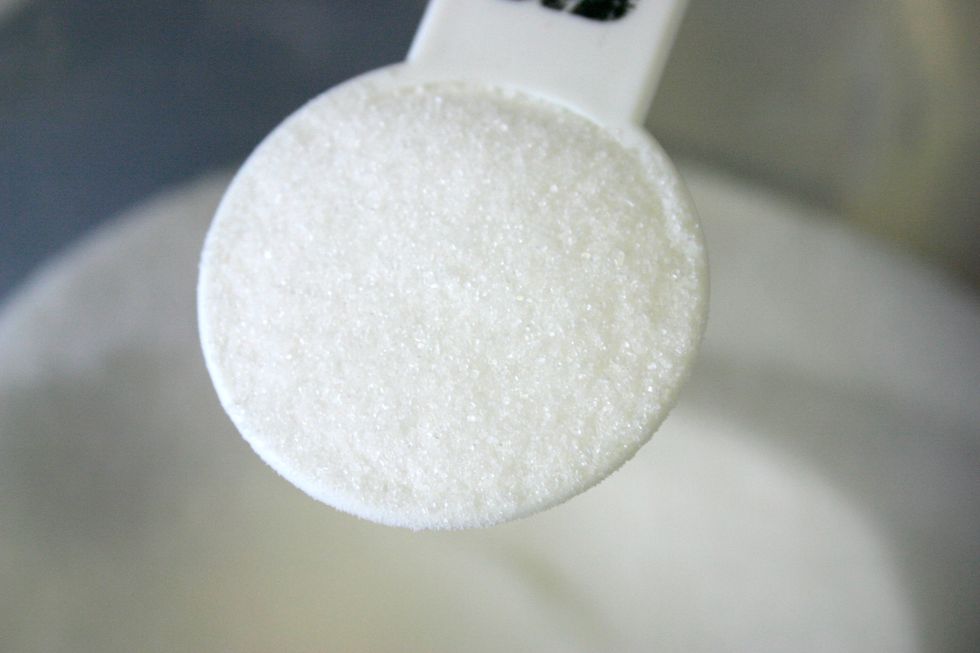*Warning* Lots of science words ahead! This is maybe a little dry at the beginning, but it is important to know the science!
What is sugar?
Sugar is a carbohydrate. The carbohydrate molecules are typically composed of the basic carbon, hydrogen, and oxygen. Carbohydrates are usually the main source of energy for bodies unless you are on a special diet (i.e. Keto diets). These molecules are then divided into several different types: Glucose, Sucrose, Fructose, Maltose, and Lactose. Each of these different types is found in different sources in nature.
The most important one is glucose. Glucose is the body’s preferred energy source. Our bodies process glucose from the consumption of carbohydrates like bread, pasta, and grains. The glucose is immediately processed for energy use or is stored in muscle cells and the liver as glycogen.
Fructose is processed from many fruits and vegetables naturally and is often an additive in sodas and flavored drinks. Fructose is what makes sweet things sweet. Fructose is special because our body processes this sugar differently than the others. Since fructose is not the preferred energy source like glucose, our bodies metabolize fructose as a fat and send it to our livers.
Sucrose is what we know as the white granulated powder of table sugar. This sugar is made from extracting it from various sugary sources like sugar canes and beets. Sucrose is a combination of one molecule of glucose and one molecule of fructose.
Although, there are many other types of sugars. We are just going to look at these sugars while trying to answer if sugar is bad or not.
What happens when we digest sugar?
Once the sugar enters our digestive system, about 80% of the glucose is immediately absorbed into our blood through the lining of our intestines. The sucrose is broken apart into glucose and fructose, while the fructose is sent to the liver to be processed.
Our body recognizes the consumption of glucose and triggers the pancreas to release insulin. Insulin is a hormone made in the pancreas for the absorption of glucose. Insulin is the key that starts the chain of reactions telling our cells to absorb glucose from the bloodstream.
Side Note: Diabetes is a disease when the insulin production or response is not working correctly.
When our body needs energy, it uses the glucose in the bloodstream or glycogen stored in the liver and muscles. The glucose is broken into two parts (pyruvates) and sent into the mitochondria, the powerhouse of the cell. The pyruvates are converted into Acetyl-CoA. The mitochondria then take the Acetyl-CoA through an acid cycle and the electron transport chain producing adenosine triphosphate (ATP). ATP is the source of energy for the metabolic process. The mitochondria can’t burn off all the pyruvates, so it converts them to citrate which turns into VLDL which is stored as body fat.
All of this is dependent on the amount of energy needed by the cells. If our cells do not consume a lot of energy, then the excess glucose is converted into glycogen which is stored in our muscles for future use. If we fast and our consumption of glucose is lowered, then our bodies call about the stored glycogen to be broken down into glucose for energy consumption.
Our muscles can reach a maximum storage level of glycogen. The leftover glycogen is converted into fatty acids and then triglycerides. These are stored in our bodies as adipose tissue, otherwise known as body fat.
That is the process of metabolizing of glucose. However, we know our bodies like glucose. Now, let us look at the process for fructose.
Fructose skips a lot of the beginning metabolizing processes and is sent straight to our livers to be processed. Since most of the fructose is not absorbed into the bloodstream in the intestine, a large amount of fructose can easily cause an overload inside the liver. Each liver cell’s mitochondria are overloaded with too much pyruvate. Our bodies can only do the same thing that it does with excess pyruvates like does with glucose.
It turns them into fat (VLDL). Anything not turned into VLDL is converted into free fatty acids. Free fatty acids are known to inhibit insulin stimulators in the muscles causing an increase in insulin resistance throughout the body. Insulin resistance means that the body is not able to burn sugars normally. The excess sugars will turn into fat and more fatty acids repeating the process again and again.
All these excess fats are a major cause of heart disease, fatty liver diseases, obesity, and diabetes.
A quick less scientific summarization: You eat sugar. The sugar enters your digestive tract where your body recognizes which sugar it is. Sucrose is split into glucose and fructose. Glucose is sent into the bloodstream for immediate energy consumption. Fructose is sent to the liver. Insulin is triggered off glucose consumption. Insulin tells the cells to absorb glucose for energy. Fructose does not trigger insulin since it does not need insulin to be processed. This leads to the overwhelming of liver cells causing the production of body fat and fatty acids. Fatty acids slow insulin release causing more body fat and fatty acids to be produced, restarting the chain.
What does our brain experience on sugar?
Our brain wants to be fed sugar to provide it with energy. Sugars are easily processed and metabolized by our bodies into energy. Our brain knows that sugars are easily turned into pure energy. Therefore, our brains love sugar. Our bodies will release dopamine and lower serotonin while processing sugar because it is letting us know it is happy. Dopamine is what tells our brains that whatever it is experiencing it is worth getting more. Serotonin is what tells our brains that it is content with what’s happening. This combination is what creates the sugar-high.
When you take a bite of cake, your brain recognizes it is eating something sugary. The sugar in the cake causes a release of dopamine. The dopamine goes into what is called the mesolimbic pathway. Inside our brains, the amygdala is triggered telling our bodies this is awesome, and it wants to eat the cake again. The hippocampus then is like great, let me remember everything about this experience. The nucleus accumbent responds by controlling our motor functions and tells us to take another bite of the cake. The prefrontal cortex then responds and focuses your attention on the cake. Naturally, you take another bite and repeat the entire process.
This system is how people can become addicted to drugs. Certain drugs, such as cocaine, cause a massive release of dopamine and severely lowers serotine in our bodies. This large amount of dopamine causes a euphoria, a high. While at the same time, since serotonin is lowered. The body is never content. It is this high and feeling unsatisfied that people will start increasingly craving the drugs causing them to become addicted to the substance. Sugar can be scary because it uses the exact same system. The next time you start craving that sugary treat it may be because your body is addicted to the sugar high.
Is sugar bad for you?
Most sugars are not bad for you. Glucose is not bad for you. Lactose is not bad for you. Many others are not bad for you. However, consuming a lot of fructose is bad for you.
I can tell you a ton of statistics about the terrible effects of fructose on our bodies, but I won’t. I won’t because most of those statistics are from people who were unaware the amount of sugar they were eating.
Go back and read how the digestive track metabolizes the sugars. You will notice I added the word “excess” a lot when describing the bad effects of sugar. Sugar is not the problem. Glucose, sucrose, and fructose are all found naturally in the foods. They are all healthy naturally occurring things to eat. However, we need to be aware how much sugar we are consuming.
Looking at the effects of sugar, with obesity and heart disease being the front-runners. While also taking into consideration how easy it is for our brains to become hooked on the substance. It seems to be a no-brainer why our culture’s number one killers are obesity and heart disease.
How much sugar are you consuming?
Let us look at one basic day of eating. For breakfast, you eat a bowl of cereal. You grab a coffee shop mochaccino on the way to work. For lunch, you grab a burger with a soda. For an afternoon snack, you grab an apple. For dinner, you have some spaghetti. Without even realizing it, you just ate sugar for every meal.
Cereal averages at 19.8 grams of sugar in each serving. Mochaccinos, if you get whipped cream, averages at 73.8 grams of sugar. Most sodas have more than 35 grams of sugar per serving. Store-bought spaghetti sauce averages at 8 grams of sugar per serving.
Totaled up, without eating any candy or deserts for an entire day, you just consumed 137 grams of sugar. According to the American Heart Association, the maximum amount of sugar you should consume is 37.5 grams.
Now, most of the sugars I counted in that diet was table sugar (sucrose) which is about 45% glucose and 55% fructose. However, most major food companies are adding fructose in the forms of crystalline fructose or an almost pure fructose form of corn syrup, known has high fructose corn syrup. You may have heard that name before. High fructose corn syrup is added to beverages, yogurts, baked goods, energy drinks, and many other processed foods to give them that delicious sweet flavor.
More than 80% of packaged foods have sugar added to them. This sugar is not added to only increase the flavor, but also the shelf life of products.
Something people tend to forget is the massive refinement process of sugars going on today. In one sugar cane, 50% of its weight is the juice and about 20% of the juice is sugar. A sugar cane by itself is only about 10% molecular sugar. To be able to reach the 37.5 grams of recommended sugar in a daily diet. You would need to consume 2lbs of sugar cane.
Our bodies are missing all the fiber found in the sugar cane when we consume that much sugar. Fiber slows down the digestion of sugars. We are basically mainlining straight sugar. Our bodies is forced to try and process it quickly before it caused the overload in our liver cells.
I highly recommend you lower your consumption of processed sugars, especially fructose. Since sugars are almost added to everything now a days. You will need to do a lot of very careful label reading to be able to cut out a lot of sugar in your diet.
If you don’t believe me or any of the science I have told you today. Give it a shot. Try and cut most of the sugar from your diet. You will feel terrible for the first couple days as your body goes into withdrawals from the substance. However, the result will be a healthier body and a healthier lifestyle. One meal will not make a difference. If you want to try and beat sugar while lowering your chances for heart disease and obesity, it takes a thousand meals to make a difference.



 Photo by
Photo by  Photo by
Photo by  Photo by
Photo by  Photo by
Photo by 


 people sitting on chair in front of computer
people sitting on chair in front of computer



 all stars lol GIF by Lifetime
all stars lol GIF by Lifetime two women talking while looking at laptop computerPhoto by
two women talking while looking at laptop computerPhoto by  shallow focus photography of two boys doing wacky facesPhoto by
shallow focus photography of two boys doing wacky facesPhoto by  happy birthday balloons with happy birthday textPhoto by
happy birthday balloons with happy birthday textPhoto by  itty-bitty living space." | The Genie shows Aladdin how… | Flickr
itty-bitty living space." | The Genie shows Aladdin how… | Flickr shallow focus photography of dog and catPhoto by
shallow focus photography of dog and catPhoto by  yellow Volkswagen van on roadPhoto by
yellow Volkswagen van on roadPhoto by  orange i have a crush on you neon light signagePhoto by
orange i have a crush on you neon light signagePhoto by  5 Tattoos Artist That Will Make You Want A Tattoo
5 Tattoos Artist That Will Make You Want A Tattoo woman biting pencil while sitting on chair in front of computer during daytimePhoto by
woman biting pencil while sitting on chair in front of computer during daytimePhoto by  a scrabbled wooden block spelling the word prizePhoto by
a scrabbled wooden block spelling the word prizePhoto by 
 StableDiffusion
StableDiffusion
 StableDiffusion
StableDiffusion
 StableDiffusion
StableDiffusion

 women sitting on rock near body of waterPhoto by
women sitting on rock near body of waterPhoto by 



